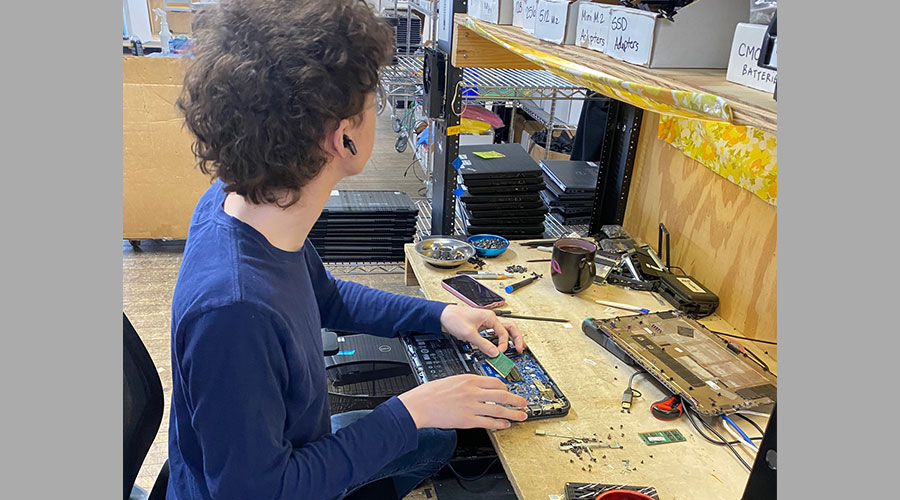Rightsizing Dumpsters with Sonar Technology
Sonar sensors help school district prevent overflowing containers and reduce operating costs.
By Lisa Ridgely, Contributing Writer
At the beginning of the 2023 school year, Julius Carter was facing an unprecedented dilemma.
As the facilities director for Issaquah School District outside of Seattle, he was reeling from post-pandemic budget cuts that resulted in staff reductions. Of particular concern was the elimination of the full-time resource conservation manager position, which was responsible for ensuring the district had sustainable practices in place — including energy and water efficiency and waste reduction.
“We were doing a lot of good things around being environmentally friendly and sustainable,” Carter says. Those duties would now fall on him, and with an overloaded plate, he was trying to find efficient ways to keep building on that sustainability momentum.
Also on his radar were new requirements related to energy efficiency benchmarks in commercial facilities that were part of the Washington Clean Buildings Act.
Carter didn’t know how he would juggle these responsibilities on top of his daily facilities director leadership duties. His “plate” was overflowing.
That October, at the annual Washington Association of Maintenance and Operations Administrators (WAMOA) conference, Carter attended with a mindset focused on finding ways to keep making positive progress with sustainability efforts.
That’s where he met Erik Makinson, founder and president of sustainability consultancy Resource Synergy.
After talking with Carter about the Issaquah School District’s resource challenges, Makinson suggested a partnership that focused on rightsizing and optimizing waste management solutions.
Innovative, sustainable solutions
When the resource conservation manager position was eliminated and those responsibilities fell on the facilities department, it created a waste management workload that was beyond their capacity to manage well.
“Managing dumpsters was just not getting done, so dumpsters were overflowing, custodians weren’t receiving the level of support they might otherwise need or expect,” Makinson says.
What makes the Issaquah School District unique is its large geographic size — with about 27 facilities, it covers about 110 square miles across seven municipalities. Whereas most school districts are typically in one municipality and deal with one primary waste hauler, even if they have hundreds of school buildings, Issaquah contracts with five different haulers. That complicates communications and dispatching, especially for already overloaded facility staff.
The solution? Use sonar sensor technology as a tool to right-size the district’s dumpsters, and to provide a service that acts as a communications liaison between the district and its waste haulers to optimize the dispatching of work orders.
“Where this service evolved to fit the need is, it allows us to take that workload off of the facilities department and ensure that it gets done — that containers are optimized, that custodians aren’t dealing with overflowing containers, but also do so in such a way that it actually reduces the costs for the district versus adding operating costs,” Makinson says.
For Carter, the simplification of hauler communications alone was a huge win.
“Instead of having to figure out, for all our different schools, which waste provider was servicing which building, they did all that for us and set up a dashboard system where we are able to interact in one central place,” Carter says. “To simplify that process was amazing.”
Sonar sensor technology
Makinson says he learned about dumpster sensors about a decade ago with a former employer.
“We were looking at ways to right-size dumpsters — adjusting the service frequency or size of the dumpsters when we couldn’t physically be on site to do so.”
At the time, the technology hadn’t evolved to be accurate enough to implement for large companies on a global scale. But revisiting it more recently for Resource Synergy projects, the opportunity to utilize sonar sensors became clear.
After exploring and piloting different technologies including camera-based and ultrasonic sensors, Resource Synergy decided on a manufacturer that makes very durable, reliable sonar devices that accurately ascertain a container’s fullness and can withstand violent environments.
“The most valuable thing is knowing how full a dumpster is and when it has been serviced,” Makinson says.
The dashboard then provides real-time metrics on the load levels in the school district’s waste containers. This type of monitoring not only saves district staff time by not having to check each container for fullness, it also helps eliminate trips by haulers to empty containers that aren’t full.
Over time, the monitoring also indicates whether a different size of container or different hauling schedule is needed.
Essentially, the service has paved the way for easy, on-demand waste hauling.
“The magic is when our team, twice daily, goes in and references all the sensors in our school district accounts, then issues work orders to the respective haulers alerting them of where they missed pickups, where containers are overflowing, or where there’s opportunity to reduce container size or frequency to save the districts money,” Makinson says.
The real-time communication enabled by the dispatch tool replaces labor-intensive emails. The threads that used to go back and forth between sites and haulers, with additional people being copied, could quickly become an administrative chore to be managed throughout the workday. Removing email from the equation has made it easier for staff and site custodians, Carter says.
“It takes a lot of lift off our custodial department so they can focus on cleaning the schools and making sure they are healthy for the students,” he says.
Haulers benefit, too
The benefits of this system extend to the haulers as well, as Makinson and Carter soon discovered.
“I was a little worried about how they would respond to the changes in scheduling, but they really embraced it,” Carter says.
One consistent point of contact provided through the dashboard system has consolidated and simplified communications, and the increased awareness of dumpster status prevents unnecessary trips throughout Issaquah’s wide geographic area.
“They don’t want their employees driving all over the place to pick up a half-full dumpster,” Carter says. “They’re using less gas, saving time, and getting to the sites that actually need service. It’s a huge sustainability win for them, too.”
In this post-pandemic labor environment, staffing is another challenge for haulers. And picking up empty dumpsters is demoralizing for overworked drivers. With limited staff and vehicles, haulers are sometimes unable to get to all collections on routes, and drivers are pushing overtime to collect what they’ve committed to, Makinson says.
“If we can reduce stops on those routes, they’re actually grateful,”he adds.
Exceeding expectations
It has been more than a year since the sonar sensors were installed in the first batch of dumpsters at Issaquah. After a brief breaking-in period to install them in a portion of dumpsters and collect data for quality assurance, the sensors were delivering real-time predictive intelligence right away.
“The value proposition is, we can now have haulers come on demand because we know exactly what waste levels are in those dumpsters,” Carter says.
The cost savings enabled by this on-demand waste hauling and communication service, after one year, is $40,000.
“What’s really been exciting is we’ve saved almost $40,000 in waste bills just by using the service, which has been fantastic,” Carter says. “We were initially thinking savings would be anywhere from $10,000 to $30,000, so we’re exceeding expectations at this point. … It’s been a pleasant surprise.”
And being able to rely on Resource Synergy to eliminate unknowns and handle the monitoring and communications has been a huge help.
“It’s almost addition by subtraction, because we lost our resource conservation manager, but the partnership we formed has helped us provide better service as a result,” Carter says. “I’ve been able to focus on the core duties of the facilities services team, which is custodial, maintenance and repairs. And we’re giving the buildings even better service now with the enhanced waste management.”
Beyond the cost savings, Carter says the partnership has provided peace of mind that waste is being properly managed and that his custodians can focus on the most important thing: providing a healthier environment for students and staff.
“If I can help a site save 15 or 20 minutes a day, not having to make that extra phone call or send an email, it gives them more time to just make the school cleaner, making sure it’s disinfected and sanitized properly,” he says.
Lisa Ridgely is a freelance writer based in Milwaukee.
Related Topics:












